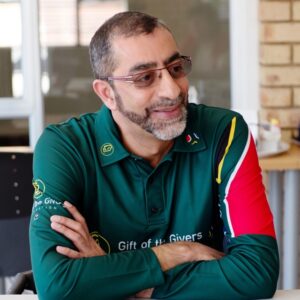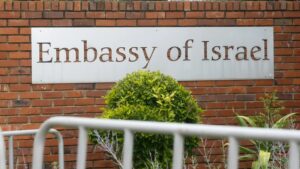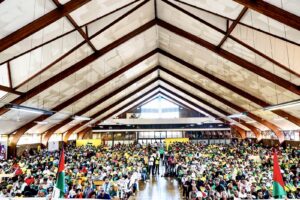By the Jordan Valley Team,
19.04.2016. Palestinian village of Al Hadidiya dry and Israeli settlement of Roi green with trees and vineyards
Al-Hadidiya is a Palestinian village located in the Northern Jordan Valley, right next to the illegal Israeli settlement of Roi. For the residents of Roi, clean safe drinking water is accessed by turning on a tap but for the residents of al-Hadidya the story is very different. This photo blog shows images of al-Hadidya’s daily struggle to access water and shows something of the human impact of the Government of Israel’s discriminatory water allocation policies in Area C of the West Bank.

02.04.2016, Abu Sakr community leader of Al-Hadidya plants an olive tree
Today there are fewer than one hundred Bedouin inhabitants living in the once thriving herder community of al-Hadidya. During the winter, the residents plant wheat and barley in the fields with the water from the rains. However, as soon as the rainy season is over, the land becomes increasingly dry and they experience severe water shortages. Their average daily consumption is approximately 20 litres of water per person; the amount the World Health Organization considers necessary for “short-term survival” in humanitarian disasters. It was not a natural catastrophe that generated these drastic conditions: it was man made.
Despite the dry appearance, deep underneath the soil lies a rich aquifer that was traditionally channelled through artisan wells and cisterns to provide enough water for this community, their crops and their animals. This is no longer the case…

Photo 2 19042016-Al Hadidiya Shepherd and his flock gather around water tank
When the West Bank was occupied by Israel in 1967, a series of military orders were issued, bringing Palestinian water resources almost exclusively under Israeli control. These military orders established that Palestinians would need a permit from Israeli authorities in order to develop water resources and related infrastructure in Area C. Any development without an Israeli-issued permit would be considered illegal and then demolished. Then in 1982, the Minister of Defense Ariel Sharon transferred all West Bank water supply systems to the Israeli national water company Mekorot. The transfer was made for the “symbolic price” of one Israeli shekel. (EWASH 2008) [1] One shekel that changed everything.

19.04.2016-Israeli Mekorot Company water pump on al Hadidiya land
Since the Oslo II Accords of 1995, this village along with 60% of the West Bank was designated ‘Area C’, placing it under full Israeli civil and security control. Much of this area has been allocated for the benefit of Israeli settlements, which receive preferential treatment at the expense of Palestinian communities.
With the Oslo Accords, the discriminatory allocation of water initiated in 1967 was perpetuated. The Israeli Authorities “allotted 80% of the water pumped from the mountain aquifer – one of three underground water reserves shared by Israel and the Palestinians – to Israel and only 20% to the Palestinians.” (B’Tselem 2014) [2]. The Oslo Accords also established that there would be no cap placed on the supply of water to Israelis while lowering the already existing cap on the supply of water to Palestinians. Although the Oslo Accords were intended to be temporary arrangement lasting only five years in the absence of a final status agreement, the Accords remain in place today, as does the discriminatory allocation of water between Israel and the Palestinians.

19.04.2016. Palestinians water tanks (foreground) and Mekorot water pump supplying settlements (background)
Unequal distribution of shared resources Before the Israeli Occupation, the villagers of al Hadidiya used to collect water from the rain and from underground springs and wells. The restrictions on this communities access to water which started with the military rules, was exacerbated by the Government of Israel’s settlement expansion policy. Firstly, the Merkorot water pump was established on the land of al-Hadidiya, causing their artisan wells and springs to dry up. The water was redirected to the nearby Roi settlement, whose residents use proportionately 20 times more water for domestic consumption than their nearby Palestinian “neighbours”. Secondly, the settlements themselves started to pour their sewage on the land, contaminating the Palestinians’ wells and cisterns.
In addition to these difficulties, the Israeli military blockades, forbidden roads, checkpoints and building restrictions, limit this community’s ability to access and develop their own water resources. The Israeli authorities also prohibit and demolish any maintenance work of the road that leads to al Hadidiya.

19.04.2016-Settlement of Roi (background) and its grape plantation foreground.
Prior to the occupation, water for livestock was traditionally gathered from nearby wells and cisterns, but now has to be brought in tanks. A tank of water usually cost about 10 times the price per cubic meter of mains water, plus the cost of transportation. In Al Hadidiya, the high cost of buying water in tanks takes a heavy toll on the villager’s finances, even influencing decisions regarding better education for children.
“Can you eat when you are thirsty?” exclaims Abu Sakr, the village community leader,“Water is the most important thing”.

02.04.2016 Palestinian drink water from pipe destined for planted olive tree in land near Al Hadidiya
Approximately 60,000 Palestinians living in Area C of the West Bank do not have access to a water system.[3] A quarter of the Palestinians that do have access to water systems only receive less than 50 liters per capita per day (l/c/d). [4] Some villages, such as al Hadidiya, receive as little as 20 l/c/d, which is significantly below the World Health Organization recommendation of 100 l/c/d. These numbers may lead one to think that there is not enough water in the Jordan Valley, but this is not the case.
Water shortages and water waste Water used to clean the motor of the Mekorot pump gets poured onto the ground even though it could be used to provided 200 cubic meters of water per day for sheep and crops in al Hadidya.

19.04.2016-Al Hadidiya wasted water from Israeli pump
The Israeli authorities do not allow Palestinian to connect pipes or use this water, nonetheless in times of scarcity the villagers collect what they can of this waste water and give it to their animals. So much water has been wasted in this way that a big crevasse has opened up on the ground.

19. 04. 2016-Al Hadidiya Crevasse created from waste water from Merkorot pump
For Abu Sakr, the objective of this policy is long established and goes beyond the settlement policy: “The Israeli objective is to ethnically cleanse the Palestinians from the Jordan Valley”. [5]
Approximately 10,000 Israeli settlers are living in the Jordan Valley, contravening international law which states that it is illegal to transfer parts of its own civilian population into the territory it occupies. [6] The settlers water consumption is equal to the consumption of almost one third of the 2,7 million Palestinians living in the West Bank. Even though the Palestinian population is 270 times bigger than the population of settlers in the Jordan Valley. [7] A more equitable distribution of water resources would increase Palestinian GDP by 10%, according to the World Bank.[8]

19.04.2016 – Al Hadidiya pipes connecting to water being wasted by Mekorot pump
International Law: Israel, as the occupying power in the West Bank, has a legal obligation to protect the Palestinian civilian population and to administer the territory for their benefit [Article 55 of the Hague Regulations of 1907]. However, the Government of Israel’s policies and practices in Area C, including its settlement policy, have severely restricted the ability of Palestinians access water which is vital for their lives and livelihoods.

02.04.2016- Child looks at an Olive Tree sapling being watered on land under at risk of being confiscated by settlers, close to al Hadidiya
“We don´t need water tanks from foreign countries, we need that these countries pressure Israel to end the occupation.” concludes Abu Sakr.

Palestinians are being denied one of their most basic human needs – access to clean safe drinking water – your support is needed! Please visit Thirsting for Justice – and learn what you can do to end water inequality and ensure Palestinian rights to water and sanitation.
Click here to view the info-graphic on the situation of water in the Jordan Valley by Al Haq.
Footnote:
[1] EWASH, Fact Sheet: Water resources in the West Bank.
[2] UNOCHA, Restricting Space: The planning Regime Applied by Israel in Area C of the West Bank, Special Focus, December 2009, p. 12.
[3] World Bank, Assessment of Restrictions on Palestinian Water Sector Development,Report No. 47657-GZ, April 2009, p. 17.
[4] These numbers may vary according to different sources.
[5] Referring to Israeli policies as “ethnic cleansing” is controversial and does not reflect the position of the WCC. This usage of the term has been propagated by Israeli historian and socialist activist Ilan Pappé, a professor with the College of Social Sciences and International Studies at the University of Exeter in the United Kingdom
[6] Convention (IV) relative to the Protection of Civilian Persons in Time of War. Geneva, 12 August 1949, Article 49.
[7] B’Tselem, Dispossession and Exploitation: Israel’s Policy in the Jordan Valley and Northern Dead Sea, 2011.
[8] World Bank, Assessment of Restrictions on Palestinian Water Sector Development,Report No. 47657-GZ, April 2009, p. 27.
More Information:
B’Tselem: Click here for figures on water consumption in the West Bank.
B’Teslem: Background on al-Hadidiya and The village of al-Hadidiya
EAPPI blog: Al Hadidya: bulldozers razed this hamlet
OCHA: Humanitarian Fact Sheet on the Jordan Valley and Dead Sea Area
United Nations Human Rights Council 2012 Report: Fact-finding mission to investigate the implications of the Israeli settlements on the civil, political, economic, social and cultural rights of the Palestinian people throughout the Occupied Palestinian Territory, including East Jerusalem





